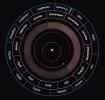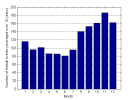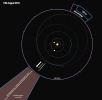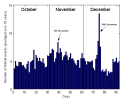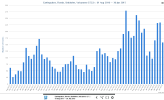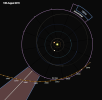tohuwabohu
Jedi Master
I had to really think about the constellations because we are not interested in subjective astrology but in objective reality. I think when the Cs told us back in 1998 that the companion is in the Libra constellation they meant it objectively. So as to looking at the sky and finding the Libra constellation. This as it turns out is a big clue, nevertheless those rascals didn't mention how distant it is and therefore we know only the direction.
Since then the companion moved surely.
One has to dig to find the truth. Fortunately I came across links to International Astronomical Union which defined the constellations of the zodiac based on observations. It can vary by one or two days because of the leap years but it is as close as we can get. The result can be seen in Fig. 59.
And sure enough Sun is in Libra during November. So it seems that we are on the right track! It is in agreement with the peak in the fireball observations.
The density of the rocks in the vicinity of Earth orbit is visualized by the brown stripe. The intensity of the color is proportional to the number of observed fireballs averaged over last 10 years. The chart with the averaged values is shown in Fig. 60.
Only after I made the visualization I discovered anomaly in the fireball observations. Namely in the simulation the dense region was symmetric with regard to the peak value. The peak being in November means that December and January should be roughly equal to October and September values. Not only is September with higher values compared to January but there is also August with values almost on par with September. I cannot explain this except by admitting possibility of some other source the is contributing to August and September months. It is possible that the cometary swarm might have some precursor.
So the conclusion is that we know the direction where the companion was some time ago in the past. But that is all. And because we do not know how far it was, it is not possible to determine how long it takes for the rocks to reach the inner solar system.
Since then the companion moved surely.
One has to dig to find the truth. Fortunately I came across links to International Astronomical Union which defined the constellations of the zodiac based on observations. It can vary by one or two days because of the leap years but it is as close as we can get. The result can be seen in Fig. 59.
And sure enough Sun is in Libra during November. So it seems that we are on the right track! It is in agreement with the peak in the fireball observations.
The density of the rocks in the vicinity of Earth orbit is visualized by the brown stripe. The intensity of the color is proportional to the number of observed fireballs averaged over last 10 years. The chart with the averaged values is shown in Fig. 60.
Only after I made the visualization I discovered anomaly in the fireball observations. Namely in the simulation the dense region was symmetric with regard to the peak value. The peak being in November means that December and January should be roughly equal to October and September values. Not only is September with higher values compared to January but there is also August with values almost on par with September. I cannot explain this except by admitting possibility of some other source the is contributing to August and September months. It is possible that the cometary swarm might have some precursor.
So the conclusion is that we know the direction where the companion was some time ago in the past. But that is all. And because we do not know how far it was, it is not possible to determine how long it takes for the rocks to reach the inner solar system.

